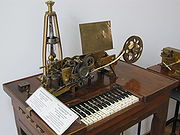
Printing telegraph
Encyclopedia

Royal Earl House
Royal Earl House was the inventor of the first printing telegraph, which is now kept in the Smithsonian Institution. His nephew Henry Alonzo House is also a noted early American inventor....
(9 September 1814 - 25 February 1895) in 1846.
The device was made by linking two 28-key piano-style keyboards
Musical keyboard
A musical keyboard is the set of adjacent depressible levers or keys on a musical instrument, particularly the piano. Keyboards typically contain keys for playing the twelve notes of the Western musical scale, with a combination of larger, longer keys and smaller, shorter keys that repeats at the...
by wire. Each piano key represented a letter of the alphabet and when pressed caused the corresponding letter to print at the receiving end. A "shift" key
Shift key
The shift key is a modifier key on a keyboard, used to type capital letters and other alternate "upper" characters. There are typically two shift keys, on the left and right sides of the row below the home row...
gave each main key two optional values. A 56-character typewheel at the sending end was synchronised to coincide with a similar wheel at the receiving end. If the key corresponding to a particular character was pressed at the home station, it actuated the typewheel at the distant station just as the same character moved into the printing position, in a way similar to the daisy wheel printer
Daisy wheel printer
Daisy wheel printers use an impact printing technology invented in 1969 by David S. Lee at Diablo Data Systems. It uses interchangeable pre-formed type elements, each with typically 96 glyphs, to generate high-quality output comparable to premium typewriters such as the IBM Selectric, but two to...
. It was thus an example of a synchronous data transmission
Data transmission
Data transmission, digital transmission, or digital communications is the physical transfer of data over a point-to-point or point-to-multipoint communication channel. Examples of such channels are copper wires, optical fibres, wireless communication channels, and storage media...
system. House's equipment could transmit around 40 instantly readable words per minute, but was difficult to manufacture in bulk. The printer could copy and print out up to 2,000 words per hour. This invention was first put in operation and exhibited at the Mechanics Institute in New York in 1844.
House’s Type Printing Telegraph of 1849 was Royal Earl House's second and much improved type-printing instrument and was widely used on lines on America's east coast from 1850.
Hughes Telegraph devices, which also had piano style keyboards, were very popular in France, where there were likely many more piano
Piano
The piano is a musical instrument played by means of a keyboard. It is one of the most popular instruments in the world. Widely used in classical and jazz music for solo performances, ensemble use, chamber music and accompaniment, the piano is also very popular as an aid to composing and rehearsal...
and harpsichord
Harpsichord
A harpsichord is a musical instrument played by means of a keyboard. It produces sound by plucking a string when a key is pressed.In the narrow sense, "harpsichord" designates only the large wing-shaped instruments in which the strings are perpendicular to the keyboard...
players than telegraphers.
Early stock ticker
Stock Ticker
Stock Ticker is a now out of print board game that was popular upon its release and is still played today. It was released by Copp-Clark Publishing, a venerable Canadian publisher.-Game play:...
machines are also examples of printing telegraphs.
Advantages
The benefit of the Printing Telegraph is that it allows the operator to use a piano-style keyboard to directly input the text of the message. The receiver would then receive the instantly readable text of the message on a paper strip. This is in contrast to the telegraphs that used Morse CodeMorse code
Morse code is a method of transmitting textual information as a series of on-off tones, lights, or clicks that can be directly understood by a skilled listener or observer without special equipment...
dots and dashes which needed to be converted into readable text.
Below is an example of how the advantage of the printing telegraph was used in advertising:
"The Western Union
Western Union
The Western Union Company is a financial services and communications company based in the United States. Its North American headquarters is in Englewood, Colorado. Up until 2006, Western Union was the best-known U.S...
Telegraph Company is now putting in a new patent telegraph printing machine on the Chicago line and hereafter dispatches transmitted over this line will be printed as they are received at the office in this city. The machine is furnished with keys similar to a piano, each key representing a letter in the alphabet, and by a peculiar mechanical arrangement each letter is printed as it is received at the office. Thus all mistakes arising from blind chirography
Chirography
Chirography is the study of penmanship and handwriting in all of its aspects ....
will be thoroughly appreciated by our citizens. The machine will be put into operation this afternoon."
Disadvantages
Printing Telegraphs were quite temperamental and suffered frequent breakdowns. Transmission speed was also much slower than the Morse system. The complexity of the original House device meant that production was limited. An improved version was designed by George Phelps. The GlobotypeGlobotype
thumb|300px|right|The Globotype is a color display for telecommunications. It was invented and patented by David McCallum of Stonehouse, Devon, England. The device features very low cost and does not use consumable supplies. It is Royal Letters Patent No. 2924 issued December 29, 1855...
was invented by David McCallum as a response to problems with the printing telegraph.
Key Layouts


